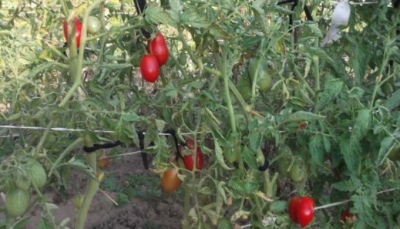
- Authors: Ugarova S.V., Dederko V.N., Postnikova T.N.
- Year of approval: 2008
- Category: grade
- Growth type: determinant
- Appointment: fresh consumption, for pickling and canning, for whole-fruit canning
- Ripening period: mid-season
- Ripening time, days: 105-110
- Growing conditions: for open ground
- Marketability: high
- Transportability: high
Many gardeners and farmers prefer classic proven varieties that are stable and fruitful in almost all weather conditions. One of these tomato species is the mid-season Solokha variety, which grows well on unprotected soils.
Breeding history
The mid-season tomato Solokha was created by a group of domestic breeders (V.N.Dederko, T.N. Postnikova and S.V. Ugarova) in 2007. The tomato appeared in the State Register of Breeding Achievements of the Russian Federation in 2008. It is recommended for cultivation of the nightshade crop in open ground. The variety has been zoned to all regions of the country - West Siberian, Central, North, Volgo-Vyatsky, Far Eastern, Ural, Central Chernozem.
Description of the variety
Solokha varietal tomato is a medium-sized plant of the determinant type. The bush will grow up to 65 cm. It is characterized by an average foliage with dark green leaves, moderate branching, an erect central stem, a strong root system that feeds the plant, and inflorescences of a simple type. On a healthy bush, up to 9-10 fruitful clusters are formed, where 4-5 berries are tied.
The plant's agricultural technology is very simple - if you wish, you can form a bush in 3-4 stems, and there is no need for a garter to support and pinch. Some summer residents note the need to remove excess leaves in the lower part of the bush, which will prevent the formation of excessive dampness. Solokha tomato has a universal purpose, so it can be eaten fresh, canned, pickled, salted, processed into juices and pastes. Due to its shape and size, the vegetable is ideal for canning whole fruits.
The main qualities of the fruit
Vegetable culture belongs to the class of medium-fruited. The vegetable gains a mass of 79 grams, but under favorable conditions the tomatoes grow up to 130-200 g. The shape of the berries is beautiful, pear-shaped (plum-shaped) with a perfectly smooth surface. Ripe tomato has a uniform bright pink color. In a state of technical ripeness, tomatoes are covered with a green color with a dark speck at the base. The skin of the vegetable is firm, but not tough.
The advantage of tomatoes is resistance to cracking, transportability and long shelf life. In addition, the fruits are endowed with high commercial qualities.
Taste characteristics
Solokha tomato is characterized by excellent taste. The flesh of the vegetable is fleshy, dense, moderately juicy, with a small content of seeds. The sugar level in the pulp reaches 4.5-5%. The taste is dominated by pleasant sweetness and sugariness without any acidity. The aroma of the tomato is classic, fresh and spicy. When eaten, the peel is not felt.
Ripening and fruiting
The tomato ripens in medium terms. From the mass germination of seedlings to ripe berries on the branches, 105-110 days pass. Ripening in the culture is long. The active phase of fruiting occurs in July-September.
Yield
The yield indicator for the species is good, the main thing is to follow all the recommendations for care. The manufacturer claims that 3 kg of ripe tomatoes can be removed per 1 m2 per season. In practice, the figures are slightly higher - 9-11 kg of berries per 1 m2.
The timing of planting seedlings and planting in the ground
Sowing seeds for seedlings is carried out from the end of March to the first days of April (55-60 days before transplanting into open soil). Before sowing, the seedlings are disinfected.Germination usually occurs on 6-8 days. To accelerate the emergence of seedlings, you can apply the greenhouse effect using glass or polyethylene. Seedlings love warmth and light. When 2-3 leaves appear, the bushes are planted in individual containers. 15 days before planting, the bushes are hardened, which will help the plants quickly adapt to new growing conditions.
Landing on the garden bed is performed from late May to early June, when the soil and air are warm enough. It is recommended to transfer the bushes on a cloudy day.

Growing tomato seedlings is an extremely important process, because it largely depends on whether the gardener will be able to harvest at all. All aspects must be taken into account, from seedbed preparation to planting in the ground.
Landing scheme
The planting scheme and the density of the placement of bushes must be observed when growing Solokha tomatoes. You can have 4-5 tomato bushes per 1 m2, which will provide sufficient air and light. The optimal layout for planting is 50x70 cm.

Growing and care
The variety is unpretentious to soils. The most productive tomato on loose and fertile soils, where zucchini, carrots and greens used to grow. More important for the culture is comprehensive care, including such activities: irrigation with warm water (drip system), fertilization, weeding and loosening of the soil, thinning of foliage, protection from insects and viruses.




A plant needs different micronutrients at each stage of growth. All fertilizers can be divided into two groups: mineral and organic. Folk remedies are often used: iodine, yeast, bird droppings, eggshells.
It is important to observe the rate and period of feeding. This also applies to folk remedies and organic fertilizers.
Disease and pest resistance
The culture has a strong immune system, so the tomato is not subject to fusarium wilt and verticillosis.


Resistant to adverse weather conditions
Due to its resistance to stress, Solokha gives good yields even with temperature fluctuations, intense heat, and short drought. In addition, tomatoes can grow in shaded areas.

























































































